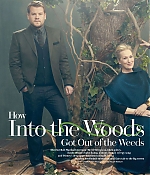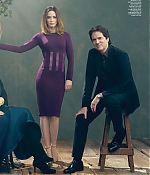
|
How "Into the Woods" Got Out Of The Weeds
The Hollywood Reporter ·
December 19, 2014
· Written by Seth Abramovitch
|

And so it was that in the spring of 2013, Meryl Streep found herself arriving at the 84-year-old composer’s five-story Manhattan townhouse. She’d just been cast as the Witch in the big-screen version of Into the Woods, Sondheim’s darkly twisted musical about fractured fairy tales. Rob Marshall, who would direct Streep in the film — opening Christmas Day — also was called to the town house, as was James Lapine, who wrote the book for the play. But none of them had any idea why they had been bidden. It turned out Sondheim had a new tune he wanted to run by them. It was called “She’ll Be Back,” and the composer thought the Witch could sing it at the point in the story when Rapunzel (played by MacKenzie Mauzy) escapes from the tower to run off with a handsome prince (Billy Magnussen). “I was in his living room and I had the sheet music in front of me and I was gasping because I didn’t know where to look,” recalls Streep. “I thought, ‘Is he going to ask me to sing it for him?’ Because I could never do that.”
He didn’t. Sondheim performed the number himself, in what Streep describes as a “wavering, gravelly and insistent” voice. Afterward, feeling like a drama school acolyte, the three-time Oscar-winning actress sheepishly approached Sondheim and asked if he wouldn’t mind autographing her sheet music. “I’d be pleased to,” replied the great man, then scribbled something down and handed over the pages. His inscription to Streep read, “Don’t f— it up.”
From the moment it debuted on Broadway in 1987, Into the Woods bewitched audiences with its sly, postmodern spin on such Brothers Grimm tales as Little Red Riding Hood, Cinderella and Jack and the Beanstalk. Steeped in Freudian metaphor — from sprouting beanstalks to ransacked gardens — the story veers beyond Disneyfied depictions of “happily ever after” to tackle such dreary topics as death, infidelity and child abandonment. Welcome to Sondheimland, the bleakest place on Earth. There’d been talk about a movie version of the show from the start, and for good reason. It always has been one of Sondheim’s more beloved properties. The various Broadway and West End productions — like the 2002 revival with Vanessa Williams as the Witch and the 2012 Shakespeare in the Park version with Amy Adams as the Baker’s Wife — have raked in at least $200 million. Uncounted millions more if you add in the thousands of smaller productions mounted in community theaters and high school auditoriums. According to licensing company Music Theater International, about 600,000 people have been involved in various presentations of Into the Woods over the years. In Hollywood, that’s known as a built-in audience.
Still, a film version seemed cursed to spend an eternity in turn-around. It came close to happening during the early 1990s, when Columbia Pictures and the Jim Henson Company optioned the material, envisioning a mix of live actors and puppets as beastly characters like Jack’s cow, Milky White. There even was a table read in Los Angeles, with Cher playing the Witch, Robin Williams as the Baker and Goldie Hawn as the Baker’s Wife (roles now being played by James Corden and Emily Blunt — along with Johnny Depp as the Wolf, Anna Kendrick as Cinderella, Christine Baranski as Cinderella’s stepmom and Chris Pine as Cinderella’s Prince). But as Sondheim wrote in his 2011 book, Look, I Made a Hat, what seemed like a certain green light was derailed by “one of those periodic studio shake-ups where a new platoon of executives replaces the old one, eager to throw out all projects begun before their arrival.” The movie idea slumbered for another 10 years until the early 2000s, when such films as Moulin Rouge! and Marshall’s own Chicago (which earned $300 million worldwide and razzle-dazzled its way to six Oscars, including best picture), had Hollywood rediscovering the musical. Around that time, Marshall met with Sondheim to discuss turning one of his stage shows into a film — maybe Follies, his musical about fading showgirls, or Sweeney Todd (later tackled by Tim Burton). But Sondheim had something else in mind for Marshall. “I remember him saying, ‘I think Into the Woods is for you,’ ” says Marshall.
The director loved the idea — Into the Woods always had been one of his favorites — but the project would end up frozen for nearly another decade, as Marshall found himself sucked into other endeavors, including Memoirs of a Geisha in 2005 and Nine in 2009. Neither of those movies came close to matching the success of Chicago, but Marshall’s unexpected next project — the 2011 Disney tentpole Pirates of the Caribbean: On Stranger Tides — became the biggest hit of his career, earning well more than $1 billion worldwide. Suddenly, Marshall was in a position to make any picture he wanted — and what he wanted to make, finally, was Into the Woods. He called Sondheim and Lapine and announced that he was at long last ready to roll up his sleeves and get to work. He vividly remembers their reply. “They said, ‘We’d love you to do it, but just one request — that you actually make the movie.’ ” The greatest creative team in the history of Broadway musicals had waited long enough for the cameras to roll.
Into the Woods is an ensemble piece if ever there was one. But the vengeful Witch who imprisons Rapunzel in a tower looms just a little bit larger than the other characters. The part required an actress of a certain age with a big range and powerful pipes. Marshall immediately thought of Streep. If she could belt out ABBA tunes — as she had in 2008’s Mamma Mia!, her biggest hit ever, grossing $600 million worldwide — she could handle Sondheim. There was just one problem. Streep had a no-witch policy. “When I turned 40, I got three witch offers in one year,” explains Streep, 65. “And no other offers. Three offers to play a witch, but no love-interest things, no woman-scientist-adventurists, no ‘I’m out saving the world,’ no nothing. Just witches. I thought, ‘God, there’s got to be another way.’ ” Still, the Sondheim material proved too enticing to resist, and Streep ultimately broke her own rule and signed on. For the part of Little Red Riding Hood, Marshall cast Sophia Grace, a 10-year-old YouTube sensation whose rendition of the raunchy Nicki Minaj song “Super Bass” had landed her an appearance on The Ellen DeGeneres Show. And to play the big bad Wolf — possibly the creepiest character ever to crawl into a Disney film, who stalks the prepubescent Riding Hood while singing a disturbing ditty titled “Hello, Little Girl” — Marshall recruited his old Pirates pal. Theater message boards instantly blew up (“Dear God, I can never look at Johnny Depp the same way again”).
Understandably, Disney was nervous about the material. When Marshall first pitched the project in 2011 to the studio’s president of production, Sean Bailey, it seemed a natural fit. “We were finishing up Pirates and had a great experience,” recalls Bailey of the meeting. But at the time, Bailey was not “wildly familiar” with just how dark Sondheim’s telling of Brothers Grimm tales could get. After he got more familiar, he realized that Depp’s perverted wolf was the least of Disney’s problems. The studio also had issues with a key scene in which the Baker’s Wife wanders from her husband and ends up having a one-night stand with Prince Charming. “It certainly was something on our minds and we talked about it a lot,” says Bailey of the tense days leading up to a green light. “We had a lot of conversations about that going in before we even got close to closing deals.” In order to allay fears and give the studio a sense of what it was getting into, Marshall staged a three-day reading in October 2012 in New York. In front of a theater packed with Disney executives and other invitees, the workshop cast — which included Kendrick, Corden and Baranski — acted out the entire script and sang the whole score. Then they waited for the thumbs-up or -down from Disney. “After the workshop, Rob found me packing up my rucksack,” recalls Corden, 36, who was pretty sure the Baker would go to a bigger name if Disney gave the movie a green light. “I wasn’t born yesterday. I knew there were other people circling for the part. But Rob made his way through people and came over and said, ‘I promise you, if we make this film, you’re coming with us.’ ”
The reading clinched the deal. Disney was willing to make its first truly grown-up fairy tale, child-molesting wolf and all. “We talked a lot about how what Walt was really doing at his time was looking at fairy tales and reinterpreting them for his age,” says Bailey. “And Into the Woods is really about reinterpreting fairy tales in a very modern and relevant way for our time.” Still, Disney was willing to make the film only on the cheap. It was budgeted at $50 million, a quarter of what the studio was doling out for other live-action fantasies such as Maleficent and Oz the Great and Powerful. To make the film on a shoestring, cast and crew (which now included cinematographer Dion Beebe, who had worked with Marshall on Geisha, and costume designer Colleen Atwood, who earned Oscars for both Geisha and Chicago) would have to take pay cuts. Says Into the Woods producer Marc Platt, “These actors worked for very, very, very little money.”
And make no mistake — it was work. Even before the cameras started rolling, Marshall put the cast through its paces. The production process began, as all of Marshall’s movies do, with six weeks of rehearsal. That’s an unheard of amount of preparation for film actors, and Streep admits she may have gotten carried away. “I came up with a whole backstory about the Witch,” she says, “and I told it to Rob — and I could just sort of see this chagrin crossing his face, like, ‘Well … I’m not sure all that happened.’ ”
“We explored things,” Marshall reveals of those long days on a soundstage in London in August and September of 2013. “We were free to try something and then try something else — it makes you feel there’s a kind of foundation. Maybe it’s because I come from the theater. Or maybe it’s because I’m afraid to step out on the first day of filming and say, ‘OK, it’s all happening.’ But it’s key to me to create an atmosphere early on that we understand we’re making the same film.” As it happened, one of the actors was making a slightly different movie. It immediately became apparent in rehearsals that 10-year-old Grace was not right for the role. “I think I got too excited about this idea of ‘young,’ ” says Marshall. A replacement hunt was organized, ending when the director conducted a Skype audition with Lilla Crawford, the 12-year-old actress who had just played the lead in a Broadway revival of Annie. “Two hours later, they told me I got the part,” says Crawford. “They said, ‘You’re flying from New York to London tomorrow.” Literally overnight, Crawford found herself at rehearsals, standing alongside the rest of the jittery company performing Sondheim’s score in front of a 53-piece orchestra — as well as Sondheim himself.
Principal photography began in late September 2013 in the rolling hillsides, ancient forests and medieval fortresses of rural England. “All the places in my childhood were used as locations,” says Tracey Ullman, who plays Jack’s nagging mother. “I used to play in those fields.” For the most part, the two-month shoot went smoothly, save for one bump. Not long after filming began, Blunt discovered that she was pregnant with her and husband John Krasinski’s first child. Luckily, she found that her physical transformation was the perfect natural prosthetic to play the Baker’s Wife, even if it meant Atwood had to continually make alterations to keep the star squeezed into her dress. “I had bigger boobs and I was overweight,” says Blunt. “But she’s a baker’s wife, so it worked well.” (Blunt gave birth to a daughter, Hazel, in February.) But as in any good fairy tale, the real drama happened in the third act, when the film entered postproduction. As visual effects wizard Matt Johnson (World War Z) added sky-high beanstalks to the footage and transformed actress Frances de la Tour into a rampaging giant, there was some concern growing at Disney that the studio might have too many Cinderellas onscreen at the same time; Kenneth Branagh’s live-action Cinderella movie for Disney, with Lily James in the title role, also had just finished shooting (it ultimately landed a March 13 release date). Then, even more upsetting, there was a spate of bad publicity, and from a source that really hurt. Sondheim, in an interview with The New Yorker, had been quoted as saying that in the movie, unlike the play, the Prince does not sleep with the Baker’s Wife. He also was quoted as saying that the crowd-pleasing song leading up to their infidelity, “Any Moment,” had been cut. It was all untrue, of course — Marshall says Sondheim had been misquoted — but the damage had been done. Sondheim fans (nearly as fanatical as Star Wars obsessives) were outraged. They accused Disney of whitewashing the master’s work.
“Sondheim was incredibly angry,” says Marshall, who still sounds miffed over the incident. “He felt it was a complete misinterpretation of what he said.” Sondheim is less chatty with the press these days — he didn’t speak to THR for this article — but he may have simply gotten the details wrong with The New Yorker. There was a song cut from the movie — it was “She’ll Be Back,” the tune Sondheim had sung for Streep and Marshall in his living room when he summoned them to his town house. It was snipped out of the final cut after an early preview. But Sondheim fanatics don’t have anything to be upset about. The tune will not disappear altogether.
“It’s going to be on the DVD,” promises Marshall. “The song is fantastic.”



Posted on November 17th, 2024
|
Posted on November 7th, 2024
|
Posted on November 1st, 2024
|
Posted on October 10th, 2024
|
Posted on September 26th, 2024
|













